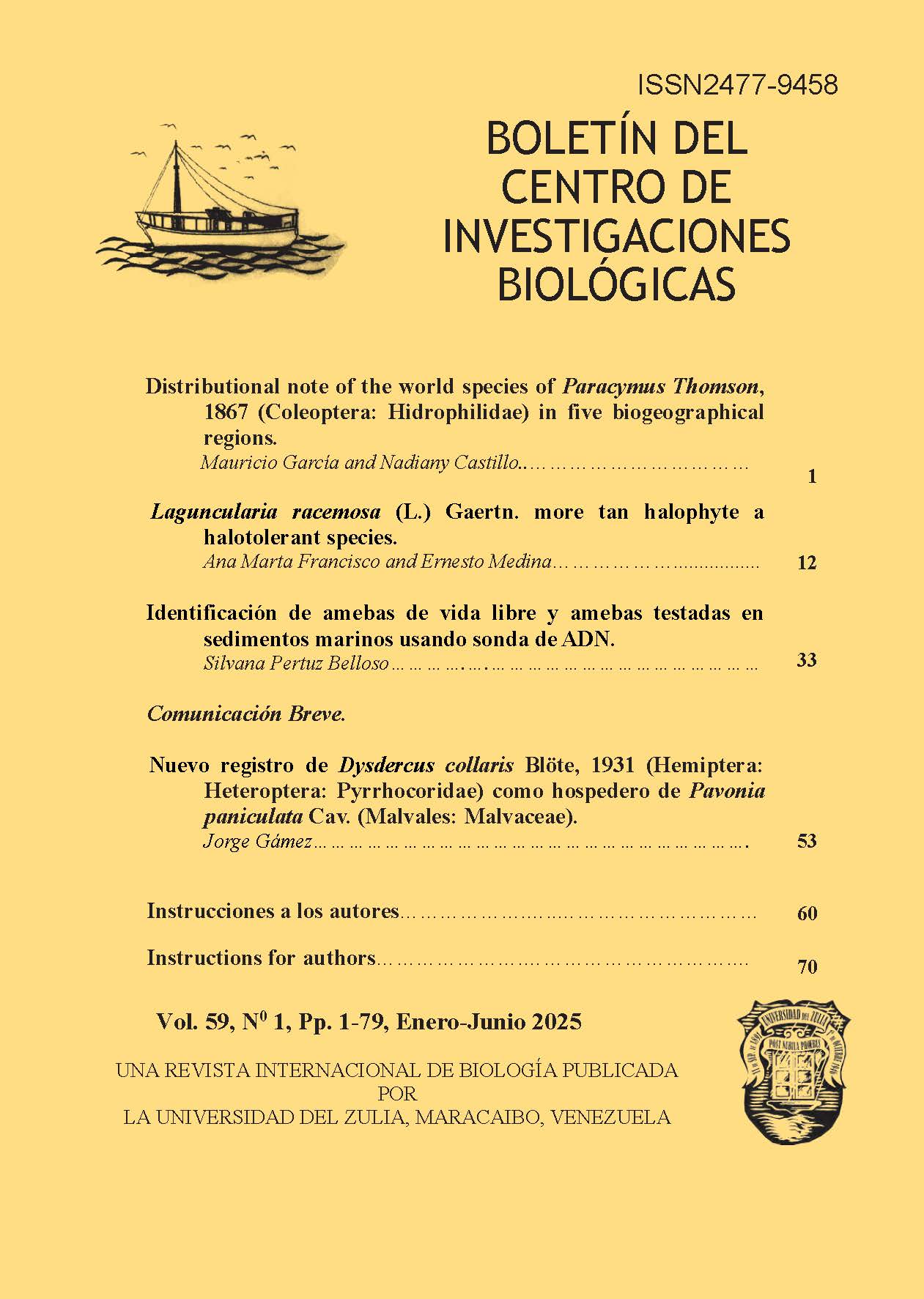Laguncularia racemosa (L.) Gaertn. más que halofita es una especie halotolerante
Resumen
Laguncularia racemosa crece en suelos que varían ampliamente en salinidad de agua intersticial, y entre las especies de mangle del Neotrópico, se caracteriza por secreción de sal y suculencia foliar y mayor concentración de Ca. Investigar las interacciones entre la absorción de cationes y salinidad en la asignación a biomasa con respuestas de crecimiento de propágulos de L. racemosa, colectados en una laguna estacional, cultivados sin sal y hasta 20-25 ‰, para demostrar el carácter halófito. Se cultivaron en invernadero con solución Hoagland al 40 % y salinidades de 0, 5, 10 y 20‰, durante 9 meses. Mediciones de: a) crecimiento (alométrico); b) azúcares solubles (colorimétrico); c) osmolalidad (osmometría) y cationes solubles (AA) en la savia de las hojas, d) fraccionamiento de Ca en hojas (AA) y e) concentración de N (micro Kjeldahl), concentración de P (colorimetría), K, Mg, Ca, Na, en la biomasa de las plántulas. La altura máxima de las plantas y la biomasa total disminuyeron linealmente con la salinidad, también en tallos, pero aumentó en raíces. Acumulación diaria de azúcar en las hojas, disminuye con la salinidad. La salinidad de las soluciones redujo las concentraciones de K, Mg y Ca en la savia de las hojas y tejidos vegetales. En hojas, las concentraciones de Ca > K y Mg, mientras que en raíces K aumentó, y la concentración de Ca y Mg en raíces variaron poco con la salinidad. La mayor fracción del Ca en todos los tratamientos fue como oxalato. Esta disminución de biomasa, altura y acumulación de iones, puede indicar que Laguncularia es una "halotolerante", pero se favorece con menor o ninguna salinidad.
Descargas
Citas
BARBOZA, F., M. B. BARRETO, V. FIGUEROA, A. M. FRANCISCO, A. GONZÁLEZ, L. LUCENA, K. Y. MATA, E. NARVÁEZ, E. OCHOA, L. PARRA, D. ROMERO, J. SÁNCHEZ, M. N. SOTO, A. J. VERA, A. L. VILLARREAL, S. C. YABROUDI AND E. MEDINA. 2006. Desarrollo estructural y relaciones nutricionales de un manglar ribereño bajo clima semiárido. Ecotrópicos. 19(1):13-29.
BIEBL, R., AND H. KINZEL. 1965. Blattbau und Salzhaushalt von Laguncularia racemosa (L.) Gaertn. f. andere Mangrove bäumeauf Puerto Rico. Österreichische Botanische Zeitschrift. 112: 56-96. https://doi.org/10.1007/bf01372978
BURCHETT, M.D., C. J. CLARKE, C. D. FIELD AND A. PULKOWNIK. 1989. Growth and respiration in two mangrove species at range of salinities. Physiologia. Plantarum. 75(2): 299-303. doi.org/10.1111/j.139-3054.198.tb06185.x
CARDONA-OLARTE P., R. R. TWILLEY, K. W. KRAUSS AND V. RIVERA-MONROY. 2006. Responses of neotropical mangrove seedlings grown in monoculture and mixed culture under treatments of hydroperiod and salinity. Hydrobiologia. 569: 325-341. https://doi.org/10.1007/s10750-006-0140-1
CHEN R. AND R. R. TWILLEY. 1999. Patterns of mangrove forest structure and soil nutrient dynamics along the Shark River estuary, Florida. Estuaries. 22: 955-970. https://doi.org/10.2307/1353075
FELLER, I. C. 1995. Effects of nutrient enrichment on growth and herbivory of dwarf red mangrove (Rhizophora mangle). Ecological Monographs. 65(4): 477-505. https://doi.Org/ 10.2307/2963499
FLOWERS, T. J. AND T. D. COLMER. 2015. Plant salt tolerance: adaptations in halophytes. Annals of Botany. 115(3): 327-331. https://doi.org/10.1093/aob/mcu267
FRANCISCO, A. M., M. DÍAZ, M. ROMANO AND F. SÁNCHEZ. 2009. Descripción morfoanatómica de los tipos de glándulas foliares en el mangle blanco Laguncularia racemosa (L.) Gaertn. f. Acta Microscópica. 18(3): 237-252.
GRATTAN S. R. AND C. M. GRIEVE. 1999. Salinity - mineral nutrient relations in horticultural crops. Sciences Horticulture. 78 (1-4):127-157. https://doi.org/10.1016/s0304-4238(98)00192-7.
GRIGORE M. N., M. VILLANUEVA, M. BOSCAIU AND O. VICENTE. 2012. Do Halophytes Really Require Salts for their growth and development? An experimental approach. Notulae Scientia Biologicae. 4(2): 23-29. https://doi.org/10.15835/nsb427606
GU X., H. FENG, T. TANG, N. FUNG-YEE TAM, H. PAN, Q. ZHU, Y. DONG, F. FAZLIOGLU AND L. CHEN. 2019. Predicting the invasive potential of a non-native mangrove reforested plant (Laguncularia racemosa) in China. Ecological Engineering. 139 (November): 105591. https://doi.org/10.1016/j.ecoleng.2019.105591
HASSID W. AND E. NEUFELD. 1964. whole starches and modified starches. [9] quantitative determination of starch in plant tissues. Methods Carbohydrate Chemistry. 4:33-36.
HIRSCHI, K. D. 2004. The calcium conundrum. Both versatile nutrient and specific signal. Plant Physiology. 136(1): 2438-2442. https://doi.org/10.1104/pp. 104.04.046490.
HOAGLAND D. R. AND D. ARNON. 1938. Growing plants without soil by the water-culture method. California Agricultural Experiment Station Circulation. 347, 32 pp.
JACKSON, M. L. 1968. Análisis químico de suelos. Editorial Omega, S.A., Barcelona, España. 662 pp.
JMP. 2014. Statistics and graphics guide, ver. 8. – SAS Institute, Cary, NC, USA. KINZEL, H. 1989. Calcium in the vacuoles and cell walls of plant tissues. Flora1. 82(1-2):99-125. https://doi.org/10.1016/s0367-2530(17)30398-5
KRAUSS, K. W. AND M. C. BALL. 2013. On the halophytic nature of mangroves. Trees. 27: 7-11. https://doi.org/10.1007/s030468-012-0767-7.
LÄUCHLI, A. AND S. GRATTAN. 2007. Plant growth and development under salinity stress. pp:1-32. In: Matthew, A, Hasegawa JPM, Mohan JS eds. Advances in Molecular Breeding Toward Drought and Salt Tolerant Crops. Springer. California. USA.
LEE, T. M. AND C. H. LIU. (1999). Correlation of decreased calcium contents with proline accumulation in the marine green macroalga Ulva fasciata exposed to elevated NaCl contents in seawater. Journal of Experimental Botany. 50(341):1855-1862. https://doi.org/10.1093/jxb/50. 341.1855
LONARD, R. I., F. W. JUDD, H. R. DE YOE AND R. STALTER. 2021. Biology and ecology of the halophyte Laguncularia racemosa (L.) Gaertn. f.: A review. In: M.-N. Grigore ed., handbook of halophytes, pp. 1803-1917. Springer Nature Switzerland ag. https://doi.org/10.1007/978-3-030-57635-6_71doi: 10.1111/j.1469-8137.2006.01851.x
LOVELOCK, C. A., I. C. FELLER, M. C. BALL, B. M. J. ENGELBRECHT AND M. L. EWE. 2006. differences in plant function in phosphorus- and nitrogen limited mangrove ecosystems. New Phytologist. 172(3): 514-522. DOI: 10.1111/j.1469-8137.2006. 01851.x
LU, Y. AND W. FRICKE. 2023. Salt stress regulation of root water uptake in a whole-plant and diurnal context. International Journal of Molecular Sciences. 24(9): 8070. https://doi.org/10.3390/ ijms24098070
LUGO, A. E., E. MEDINA, E. CUEVAS, G. CINTRÓN, E. D. LABOY-NIEVES, AND Y. SCHAEFFER-NOVELLI. 2007. Ecophysiology of a mangrove forest in Jobos Bay, Puerto Rico. Caribbean Journal of Science. 43(2): 200-219. https://doi.org/10.18475/cjos.v43i2.a6
MADI, A. P. L. M., M. R. T. BOEGER AND C, REISSMAN. 2015. Chemical composition of soil and leaves and nutrient use efficiency of mangroves species/composicao do solo e das folhas e eficiencia do uso de nutrients por especies de manguezal. Revista Brasileira de Engenharia Agricola e Ambiental. 19(5): 433 pp. Gale one file: informe académico, link.gale.com/apps/doc/a442041203/ifme?u₌anon⁓756ff36c&sid₌googlescholar&xid₌22bb57cd.
MANOHAR, S. M. 2021. A review of the botany, phytochemistry and pharmacology of mangrove Lumnitzera racemosa Willd. Pharmacogn Review. 15(30): 107-116. DOI:10.5530/ phrev.2021.15.13.
MARSCHNER, H. 1995. Mineral nutrition of higher plants. Academic Press. London.
MC KEE, K. L., I. C. FELLER, M. POPP, AND W WANEK. 2002. Mangrove isotopic (δ15n and δ13c) fractionation across a nitrogen vs. phosphorus limitation gradient. Ecology. 83(4):1065-1075. https://doi.Org/10.1890/0012-9658(2002)083[1065:minacf]2.0.co;2.
MEDINA, E., E. CUEVAS, A. E. LUGO, O. ABELLEIRA Y J. FONSECA DA SILVA. 2015a. Jobos Bay mangroves revisited: gas exchange, salinity, and nutrient relations. Acta Científica. 29(1-3): 92-108.
MEDINA, E., W. FERNÁNDEZ AND F. BARBOZA. 2015b. Element uptake, accumulation, and resorption in leaves of mangrove species with different mechanisms of salt regulation. Web Ecology. 15(1): 1-11. https://doi.org/10.5194/we-15-3-2015.
MEDINA, E. AND M. FRANCISCO. 1997. Osmolality and δ13c of leaf tissues of mangrove species from environments of contrasting rainfall and salinity. Estuarine, Coastal and Shelf Science. 45(3): 337-344. https://doi.org/10.1006/ecss.1996.0188
MÉNDEZ-ALONZO, R., C. LÓPEZ-PORTILLO, M. MONCTEZUMA K., BARTLETT AND L. SACK. 2016. Osmotic and hydraulic adjustment of mangrove saplings to extreme salinity. Tree Physiology. 36(12): 1562-1572. https://doi.org/10.1093/treephys/tpw073.
MESSEDI, D., N. LABIDI AND C. ABDELLY. 2004. Limits imposed by salt to the growth of the halophyte Sesuvium portulacastrum. Journal of Plant Nutrition and Soil Science. 167: 720-725. https://doi.org/10.1002/jpln.200420410
MOSTAFA, M. A. E. AND A. ULRICH. 1976. Absorption, distribution and form of Ca in relation to deficiency (tip burn) in sugar beets. Crop Science. 16(1): 27-30. https://doi.org/10.2135/ cropsci1976.0011183X001600010007x
MURPHY, J. AND J. P. RILEY. 1962. A modified single method for the determination of phosphate in naturals Waters. Analytica Chemica Acta. 27: 31-36. https://doi.org/10.1016/S0003-2670(00)88444-5
NANDY, P., N. DASGUPTA AND S. DAS. 2009. Differential expression of physiological and biochemical characters of some Indian mangroves towards salt tolerance. Physiology and Molecular Biology of Plants. 15: 151-160. https://doi.org// 10.1007/s1228-00-0017-7
POPP, M. 1984. Chemical composition of Australian mangroves. I. Inorganic ions and organic acids. Zeitschrift für Pflanzenphysiologie. 113(5): 395-409.
PARIDA, A. K AND B. JHA. 2010. Salt tolerance mechanisms in mangroves: a review. Trees. 24(2): 199-217. https://doi.org/10.1007/s00468-010-0417-x
QUADROS A. F., V. HELFER, I. NORDHAUS, H. REUTER AND M. ZIMMER. 2021. Functional traits of terrestrial plants in the intertidal: A review on mangrove trees. The Biological Bulletin. 241(2): 123-139. https://doi.org/10.1086/716510
RENGEL, Z. 1992. The role of calcium in salt toxicity. Plant, Cell and Environment. 15(6): 625-632. https://doi.org/10.1111/j.1365-3040.1992.tb01004
SOBRADO, M. A. 2004. Influence of external salinity on the osmolality of xylem sap, leaf tissue and leaf gland secretion of the mangrove Laguncularia racemosa (L.) Gaertn. Trees. 18: 422-427. DOI: 10.1007/s00468-004-0320-4
SOBRADO, M. A. 2007. Relationship of water transport to anatomical features in the mangrove Laguncularia racemosa grown under contrasting salinities. New Phytologist. 173(3): 584-591. https://doi.org/10.1111/j.1469-8137.2006.01927.x
SPALDING, M., M. KAINUMA AND L. COLLINS. 2010. World Atlas of Mangroves. Malta, Gutenberg Press. ISBN 978-1-84407-657-4
TOMLINSON, P. B. 1986. The botany of mangroves. Cambridge Tropical Biology Series, Cambridge University Press. Cambridge, 413 pp. ISBN 0-521-25567-8.
TOOULAKOU, G., A. GIANNOPOULO, D. NIKOLOPOULOS, P. BRESTA, F. KLAPA, AND G, KARABOURNIOTIS. 2016. Alarm photosynthesis: Calcium Oxalate crystal as an internal CO2 source in plants. Plant Physiology. 171(4): 2577-2585. DOI: 10.1104/pp.16.00111.
WANG, W., Z. YAN, S. YOU, Y. ZHANG, L. CHEN AND G. LIN. 2011. Mangroves: obligate or facultative halophytes? A review. Trees. 25: 953–963. DOI: 10.1007/ s00468-011-0570-x
WHITE, P. J. AND M. R. BROADLEY. Calcium in Plants. 2003. Annals of Botany. 92(4): 487–511, https://doi.org/10.1093/aob/mcg164
YE Y., N. F-Y. TAM, LU C-Y AND Y. S. WONG. 2005. Effects of salinity on germination, seedling growth and physiology of three salt-secreting mangrove species. Aquatic Botany. 83(3): 193-205. DOI: 10.1016/j.aquabot.2005.06.006
Los autores/as que publiquen en esta revista aceptan las siguientes condiciones:Â
- Los autores/as conservan los derechos de autor y ceden a la revista el derecho de la primera publicación, con el trabajo registrado con la licencia de atribución de Creative Commons, que permite a terceros utilizar lo publicado siempre que mencionen la autoría del trabajo y a la primera publicación en esta revista.
- Los autores/as pueden realizar otros acuerdos contractuales independientes y adicionales para la distribución no exclusiva de la versión del artículo publicado en esta revista (p. ej., incluirlo en un repositorio institucional o publicarlo en un libro) siempre que indiquen claramente que el trabajo se publicó por primera vez en esta revista.
- Se permite y recomienda a los autores/as a publicar su trabajo en Internet (por ejemplo en páginas institucionales o personales) antes y durante el proceso de revisión y publicación, ya que puede conducir a intercambios productivos y a una mayor y más rápida difusión del trabajo publicado (vea The Effect of Open Access).















